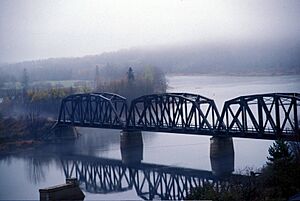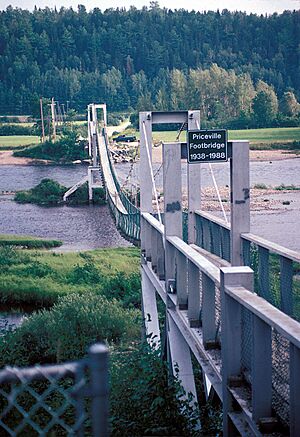Miramichi Valley facts for kids

The Miramichi Valley is a special area in the east-central part of New Brunswick, Canada. It follows the two main branches of the Miramichi River and their smaller streams. Most people agree that the Southwest Miramichi River forms the biggest part of this region because more people live there.
Contents
Exploring the Miramichi Valley
Many towns and villages are found along the Miramichi River. Starting from upriver and moving down, you'll find places like Juniper, Boiestown, Doaktown, Blackville, Red Bank, Sunny Corner, and Renous-Quarryville. The largest city is Miramichi. This city was created by joining several smaller towns and villages. These include Newcastle, Chatham, Nelson-Miramichi, Loggieville, and Douglastown.
First Nations Communities
The Miramichi River area is also home to three Mi'kmaq First Nations communities. These are:
- Natoaganeg (Eel Ground) First Nation
- Esgenoôpetitj (Burnt Church) First Nation
- Metepenagiag (Red Bank) Mi'kmaq Nation
Miramichi Valley Climate
The Miramichi Valley has a continental climate. This means it gets winds from the land, usually from the west. However, areas closer to the Gulf of St. Lawrence can get easterly winds in late summer. The nearby Gulf of St. Lawrence helps to make the weather less extreme. It keeps winters from being too cold and springs from being too early.
The Miramichi River usually freezes solid for three to four months each winter. In the past, people even drove cars across the ice before bridges were built! This is changing now due to climate shifts. The area gets about 1 to 1.1 meters of rain each year.
Forests of the Miramichi
The forests in the Miramichi Valley are very diverse. They are part of the Acadian Forest region. You can find many different types of trees here.
Coniferous Trees
Common coniferous trees (trees with needles and cones) include:
- Balsam fir
- Black spruce
- Red spruce
- White spruce
- Eastern white pine
- Red pine
- Jack pine
- Tamarack
- Eastern hemlock
- Eastern white cedar
Deciduous Trees
Deciduous trees (trees that lose their leaves in fall) found here include:
- Yellow birch
- Paper birch
- Grey birch
- Red maple
- Sugar maple
- Balsam poplar
- Trembling aspen
- Bigtooth aspen
- Speckled alder
- Northern red oak
- American elm
- American beech
- Black ash
Some less common trees like silver maple and butternut grow along the Southwest Miramichi River.
Forest Management
Many families in the valley own small areas of forest. They use these for firewood or to sell timber. Other forest lands are managed by the New Brunswick government. These lands are mainly used to support the pulp and paper industry. There has been some discussion about how these forests are managed, especially regarding clear cutting (cutting down all trees in an area).
Farming in the Valley
The Miramichi River valley has some farms, mostly on the good soil near the river. Not many crops are grown, but you might see potatoes, turnips, oats, and wheat. Many people also have small vegetable gardens for their own use. Dairy farming is common, and fruits like blueberries, strawberries, raspberries, and cranberries are grown. Some old farms that were cleared long ago have now grown back into forests.
In the spring, people also gather wild "fiddleheads." These are the curled young shoots of ostrich ferns that grow along the riverbanks after the spring floods. They are a local delicacy!
Fishing in the Miramichi
The Miramichi River is famous for Atlantic Salmon fly-fishing. In the past, the river's mouth was also a big place for catching salmon, shad, gaspereau, and smelt for sale. While these commercial fisheries have decreased, the lobster fishery has become very important. Lobster boats sail from ports like Neguac, Hardwicke, Baie-Sainte-Anne, and Escuminac. The Miramichi River also has some oyster harvesting and farming of mussels.
Sadly, many fish populations, especially Atlantic Salmon, have been declining. People blame this on things like fishing in Greenland, global climate change, and too much local fishing. Modern forest management (like clear cutting) and industrial pollution also play a part. Despite these challenges, the Miramichi River still has one of the largest yearly runs of Atlantic salmon in North America.
Wildlife in the Miramichi
The Miramichi River area is home to many land mammals and birds. You can find:
Other animals include red fox, northeast coyote, mink, fisher, weasel, skunk, porcupine, beaver, and muskrat.
Long ago, before Europeans arrived, the area also had woodland caribou, eastern cougar, and wolves. Some people think a small number of Eastern Cougars might still live in New Brunswick. A pack of Grey Wolves is also thought to have recently returned to the Miramichi Highlands.
Hunting deer, moose, ducks, and geese is allowed each fall. There is also a limited bear hunt in the spring. Hunting is an important part of the local economy.
History of the Miramichi Valley
Early Times to 1758
The Miramichi River valley was first settled by ancient groups of people. Later, the Mi'kmaq Nation lived here when Europeans first arrived. Under French rule, as part of Acadia, not many French settlers came to the region. The Mi'kmaq people of the Miramichi Valley supported France during the wars with Britain (1689-1763). They sometimes raided settlements in New England during the Seven Years' War.
In 1758, after the British captured Fortress Louisbourg, British forces attacked French settlements along the coast. They came into the lower Miramichi River valley and destroyed small Acadian villages. They also burned a Mi'kmaq village at Ste-Anne, which is now Burnt Church, NB.
From 1758 to 1850
After the Great Upheaval, the Miramichi River valley became a hiding place for Acadians fleeing from other areas. However, they soon had to move to more isolated coastal spots. The area became part of the British Colony of Nova Scotia (1756-1784) but was largely ignored. Some Loyalist refugees came from the Saint John River valley. But it was only after New Brunswick became a separate colony in 1784 that the Miramichi region gained attention.
Many Scottish people began to move to the Miramichi Valley. Some were soldiers who had fought in the American Revolutionary War. Others came directly from the Scottish Highlands due to changes there. These Scottish settlers were the first permanent English-speaking residents. Their hard work helped build the communities in the valley.
William Davidson was one of the first Scots, arriving in 1767. English settlers also came, and Anglican Churches were built. Acadians started returning around 1769, settling along the lower bay. A few Loyalists also arrived, especially upriver, where Squire Doak founded Doaktown. In 1825, a huge forest fire, known as "The Great Miramichi Fire," burned 20% of New Brunswick's forests. It destroyed several communities, including Newcastle and Douglastown.
Many Irish people arrived in the Miramichi Valley, especially after the Great Famine of Ireland (1845-1849). Middle Island, in the Miramichi River's inner bay, was used as a quarantine station for new arrivals. While some Irish immigrants farmed, many moved to the towns and villages.
Trade with Britain and the West Indies was very important for the Miramichi economy in the 1800s. A key export until the 1850s was Eastern White Pine logs, used as masts for Royal Navy ships. Later, lumber, pulpwood, and pit props (wood supports for mines) were exported. After the 1850s, the United States became the main market. Salmon and forest products were shipped to Boston, MA, and ships would return with rum and molasses.
From 1867 to Today
After Canada became a country in 1867, new government policies made it harder for Miramichi lumbermen and fish buyers to trade. High taxes on imported goods meant higher prices for locals. Also, taxes on exports to the United States made it harder to sell goods there.
Sawmills were common in Miramichi for a long time. Later, pulp mills were built in Newcastle and Chatham. The Newcastle mill operated until recently. Fish packing was also important, especially in Loggieville and Escuminac.
Railways came to the Miramichi Valley in the 1870s and 1880s. The Intercolonial Railway arrived in 1875, crossing the Miramichi Rivers near Newcastle. This railway connected Moncton, NB to Bathurst, NB. Another railway, the Northern and Western Railway (later the Canada Eastern Railway), was built from Fredericton to Loggieville. It ran along the Southwest Miramichi River through Chatham.
Large steamships and motor vessels used to visit ports along the river regularly. However, in the 1980s and 1990s, the government decided to focus all major shipping in northern New Brunswick at Belledune, NB. This led to less dredging (clearing the riverbed) in Miramichi Bay. Now, the navigation channel has a lot of silt, but some ships still visit Chatham and Newcastle.
Today, about 45,000 people live in the Miramichi River valley. Most have mixed Irish, Scottish, English, French, and Mi'kmaq backgrounds. In the past, the coastal areas were mostly Acadian fishing communities. Chatham was Irish, and Newcastle and upriver towns were Scottish. Over the last 100 years, Acadians have moved into the city of Miramichi. People of different backgrounds have often married each other, and relations are generally good.
There hasn't been much immigration to the Miramichi Valley since the Irish Famine. This has shaped the local personality. Miramichiers are known for being friendly, independent, and having a good sense of humor. They are very proud of their valley.
The two World Wars also brought people together. Many men from the Miramichi Valley were killed or wounded in the First World War. In the Second World War, Miramichi soldiers were part of the North Shore Regiment and fought in France, Belgium, and the Netherlands. Others served in the Royal Canadian Air Force and the Royal Canadian Navy.
Historic Sites to Visit
- Middle Island: This island in Miramichi Bay was a quarantine station for Irish immigrants. It is now a memorial to their journey.
- MacDonald Farm: Located at the mouth of the Bartibogue River, this is a restored home of an original Scottish settler.
- St. Michael's Basilica: Found in the former town of Chatham, NB, this is the largest church in the Miramichi Valley and was important to the Irish community.
|


